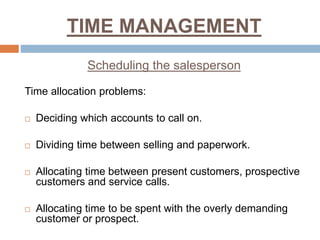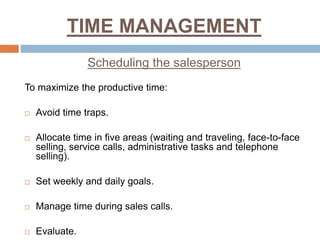TIME AND SALES TERRITORY
- 1. TIME AND SALES TERRITORY MANAGEMENT S. M. Habibur Rahman Tipu | Sales Professional Present By:
- 2. ESTABLISHING SALES TERRITORY ’é© A sales territory is usually thought of as a geographic area that contains customer accounts (present and potential). ’é© The major emphasis should be on the customers and prospects because a market is made up of people and customers, not geographic areas.
- 3. ESTABLISHING SALES TERRITORY Reasons for establishing sales territories ’é© To facilitate the planning and controlling of the selling function. ’é© To enhance market coverage. ’é© To keep selling costs at a minimum. ’é© To strengthen customer relations. ’é© To build a more effective SF. ’é© To evaluate the SF better. ’é© To coordinate selling with other marketing functions.
- 4. ESTABLISHING SALES TERRITORY Reasons for not establishing sales territories ’é© Small companies with only a few people selling in a local market. ’é© The available sales coverage is far below the sales potential of the market. ’é© Companies introducing new product or with products that everyone needs. ’é© Sales are made primarily on the basis of social contacts or personal friendships.
- 5. SETTING UP SALES TERRITORY 1. Selecting a geographic control unit ’ü▒ States, counties (region), zip code areas, cities, metropolitan areas, trading areas.
- 6. SETTING UP SALES TERRITORY 2. Making an account analysis ’é© To identify accounts by name. ’é© To estimate the total sales potential for all accounts in each geographic control unit. ’é© To classify each accounts according to its annual buying potential.
- 7. SETTING UP SALES TERRITORY 3. Developing a salesperson workload analysis A salesperson workload analysis is an estimate of the time and effort required to cover each geographic control unit. ’é© Numbers of account to be called on. ’é© The length of each call. ’é© The travel time required. ’é© The non-selling time.
- 8. SETTING UP SALES TERRITORY 4. Combine geographic control units into sales territories ’é© To group adjacent control units into territories of roughly equal sales potential.
- 9. SETTING UP SALES TERRITORY 5. Assigning sales personnel to territories ’é© Relative ability (product and industry knowledge, persuasiveness and verbal ability). ’é© Potential sales effectiveness within the territory (salespersonŌĆÖs physical, social and cultural characteristics).
- 10. TIME MANAGEMENT Scheduling the salesperson Time allocation problems: ’é© Deciding which accounts to call on. ’é© Dividing time between selling and paperwork. ’é© Allocating time between present customers, prospective customers and service calls. ’é© Allocating time to be spent with the overly demanding customer or prospect.
- 11. TIME MANAGEMENT Scheduling the salesperson To maximize the productive time: ’é© Avoid time traps. ’é© Allocate time in five areas (waiting and traveling, face-to-face selling, service calls, administrative tasks and telephone selling). ’é© Set weekly and daily goals. ’é© Manage time during sales calls. ’é© Evaluate.
- 12. Thank You !












